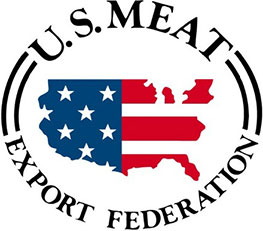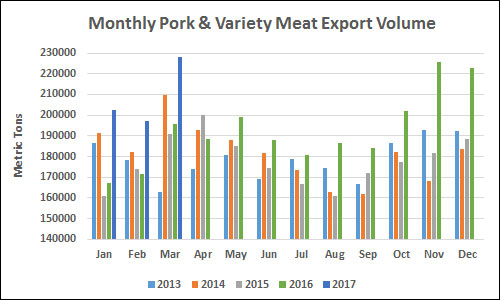 U.S. pork and beef exports capped a strong first quarter with excellent March results that included a new record volume for pork, according to statistics released by USDA and compiled by the U.S. Meat Export Federation (USMEF).
U.S. pork and beef exports capped a strong first quarter with excellent March results that included a new record volume for pork, according to statistics released by USDA and compiled by the U.S. Meat Export Federation (USMEF).
Pork exports reached 227,955 metric tons (mt) in March, up 16 percent year-over-year and topping the previous monthly high set in November 2016. Export value was $586.6 million, up 22 percent. For the first quarter, pork exports were up 17 percent in volume (627,647 mt) and 22 percent in value ($1.58 billion).
March exports accounted for 28 percent of total pork production and 23.3 percent for muscle cuts only, up from 25.4 percent and 22 percent, respectively, last year. First-quarter ratios were also significantly higher at 27.2 percent and 22.6 percent, compared to 23.9 percent and 20 percent in 2016. Export value per hog slaughtered averaged $54.93 in March, up 15 percent year-over-year, while the first-quarter average increased 18 percent to $52.42.
Beef exports totaled 105,310 mt in March, up 18 percent year-over-year, with value increasing 22 percent to $588.2 million. First-quarter beef exports were up 15 percent in volume (292,215 mt) and 19 percent in value ($1.61 billion).
March exports accounted for 12.5 percent of total beef production and just under 10 percent for muscle cuts only, each up slightly from last year. For the first quarter, the percentage of total beef production exported was down slightly from a year ago (12.4 percent vs. 12.5 percent) despite an increase for muscle cuts (9.8 percent vs. 9.4 percent). Export value per head of fed slaughter averaged $270.14 in March, up 11 percent from a year ago, while the first-quarter average increased 10 percent to $267.71 per head.
“Entering 2017 with record-large pork production and an uptick in beef slaughter, we knew this ‘wall of U.S. meat’ presented a challenge for our industry,” said USMEF President and CEO Philip Seng. “So the fact that first-quarter export volumes are higher than a year ago is not surprising, but it’s important to look beyond that – to the higher percentage of production being exported and the strong return on those exports. The U.S. is not just moving more meat internationally because we have more available. Our products are commanding solid prices and winning back market share in many key destinations, even with a strong U.S. dollar and many trade barriers still in place. But our competitors are working every day to reverse this trend, so we must aggressively expand and defend our international customer base.”
Mexico, Korea and South America fuel record volume for pork exports
 The red-hot pace for U.S. pork exports to Mexico continued in March, with volume up 34 percent year-over-year to 68,866 mt, and value increasing 47 percent to $127.2 million. For the first quarter, exports to Mexico totaled 206,262 mt (up 29 percent) valued at $371.9 million (up 42 percent). Strong demand from Mexico is especially important for U.S. ham prices, but pork variety meat exports to Mexico also posted a strong first quarter, increasing 14 percent in volume (37,596 mt) and 38 percent in value ($58.1 million).
The red-hot pace for U.S. pork exports to Mexico continued in March, with volume up 34 percent year-over-year to 68,866 mt, and value increasing 47 percent to $127.2 million. For the first quarter, exports to Mexico totaled 206,262 mt (up 29 percent) valued at $371.9 million (up 42 percent). Strong demand from Mexico is especially important for U.S. ham prices, but pork variety meat exports to Mexico also posted a strong first quarter, increasing 14 percent in volume (37,596 mt) and 38 percent in value ($58.1 million).
In leading value market Japan, March exports increased modestly in volume (37,806 mt, up 2 percent) but climbed 12 percent in value to $155.2 million – the highest since October 2014. In the first quarter, export volume to Japan was up 7 percent in volume (101,581 mt) and 13 percent in value ($411.3 million). Chilled pork exports to Japan increased 3 percent to 56,307 metric tons, while value increased 10 percent to $260 million.
Other first-quarter highlights (compared to year-ago levels) for U.S. pork included:
- Strong variety meat demand in China/Hong Kong helped drive exports to the region 5 percent higher in volume (131,036 mt) and 11 percent higher in value ($258.8 million). While muscle cut exports slowed, variety meat volume climbed 24 percent (to 86,097 mt) while value was up 29 percent to $176.2 million – making an important contribution to per-head value.
- Since posting a slow start in 2016, pork exports to South Korea have steadily regained momentum as exports totaled 51,158 mt (up 31 percent) valued at $137 million (up 39 percent). Most U.S. pork now enters Korea duty-free under the Korea-U.S. Free Trade Agreement, which has helped boost volumes of raw material for further processing, as well as processed pork products.
- Another major market rebounding from last year’s slow start is Colombia, where U.S. pork also benefits from lower tariffs secured in a recent free trade agreement. First quarter exports to Colombia doubled from a year ago in both volume (16,532 mt) and value ($36.5 million). Also bolstered by a near-doubling of exports to Chile and Peru, first-quarter pork exports to South America were up 95 percent in volume (23,838 mt) and 94 percent in value ($57 million).
- In Australia, an important market for U.S. hams and other cuts utilized in further processing, exports increased 38 percent in volume to 20,607 mt, while export value climbed 43 percent to $57.7 million.
Beef exports move higher in Asian and North American markets
 March beef exports to Japan increased 41 percent in volume (28,135 mt) and 39 percent in value ($167.7 million). This capped a very strong first quarter in which exports jumped 41 percent (to 74,411 mt) and 42 percent (to $427.3 million), respectively. This included a 55 percent increase in chilled beef volume to 33,366 mt, as U.S. beef captured its highest-ever market share in Japan’s high-value chilled sector.
March beef exports to Japan increased 41 percent in volume (28,135 mt) and 39 percent in value ($167.7 million). This capped a very strong first quarter in which exports jumped 41 percent (to 74,411 mt) and 42 percent (to $427.3 million), respectively. This included a 55 percent increase in chilled beef volume to 33,366 mt, as U.S. beef captured its highest-ever market share in Japan’s high-value chilled sector.
Coming off a record performance in 2016, beef exports to South Korea posted a very strong first quarter, with volume up 23 percent to 42,551 mt and value increasing 30 percent to $267.5 million. With U.S. beef continuing to gain momentum in Korea’s retail and restaurant sectors, first-quarter chilled beef exports were up 78 percent to 8,508 mt.
Other first-quarter highlights (compared to year-ago levels) for U.S. beef included:
- Exports to Mexico posted a solid increase in volume (57,057 mt, up 17 percent), while value increased 3 percent to $226.8 million. An important destination for shoulder clods, rounds and other beef end cuts, muscle cut exports to Mexico expanded at an even faster pace, climbing 23 percent in volume (30,015 mt) and 11 percent in value ($175.1 million).
- Despite a recent slump in the value of the Canadian dollar, beef exports to Canada have rebounded in 2017, with solid increases in both volume (29,909 mt, up 14 percent) and value ($190.5 million, up 19 percent).
- In Taiwan, where U.S. beef captures more than two-thirds percent of the chilled beef market, exports increased 28 percent in volume to 9,746 mt and 29 percent in value to $85.7 million. This included a 10 percent increase in chilled beef volume to 3,650 mt.
- Beef exports to South America were down 2 percent in volume (4,919 mt) but increased 16 percent in value ($23 million), bolstered by a strong performance in Colombia and a recent rebound in Peru. This week USDA also confirmed the arrival of the first U.S. beef shipments to Brazil since a BSE-related suspension was imposed more than 13 years ago. The first significant export volumes for Brazil will likely appear in the May USDA data, which will be available in early July.
- March exports to South Africa (1,107 mt) were the highest since the market opened last year, making it the month’s 10th largest volume destination for U.S. beef. For the first quarter, South Africa ranked 11th at 1,971 mt. Export value was $1.5 million, with most of the volume being beef livers.
Lamb export value highest in 18 months
U.S. lamb exports showed notable improvement in March as volume increased 6 percent from a year ago to 926 mt, while export value reached $2.3 million – up 35 percent and the highest since October 2015.
For the first quarter, lamb exports were still down 26 percent year-over-year in volume (1,986 mt) due to weak variety meat demand, but export value increased 10 percent to just under $5 million. Growth was driven in large part by a strong performance in the Caribbean, where volume increased 17 percent (to 187 mt) and value climbed 34 percent to $1.6 million.
Complete January-March export results for U.S. beef, pork and lamb are available from USMEF’s statistics web page.
If you have questions, please contact Joe Schuele at jschuele@usmef.org or call 303-226-7309.
NOTES:
- Export statistics refer to both muscle cuts and variety meat, unless otherwise noted.
- One metric ton (mt) = 2,204.622 pounds.










